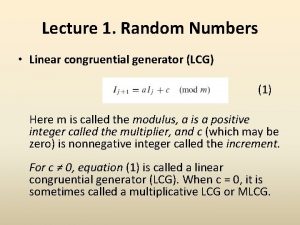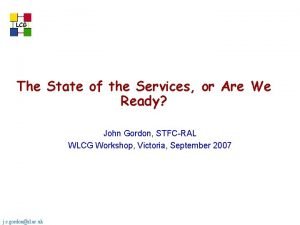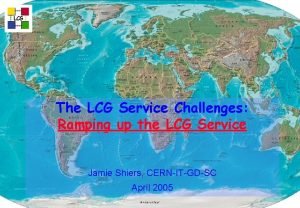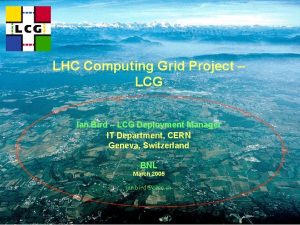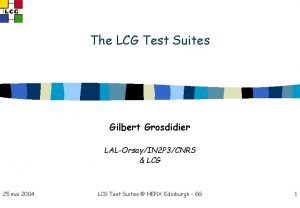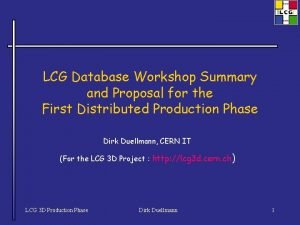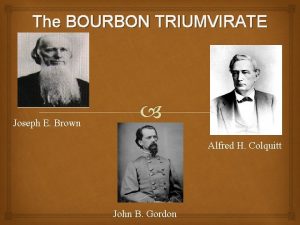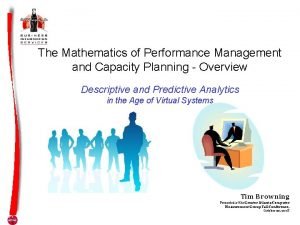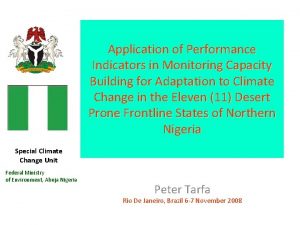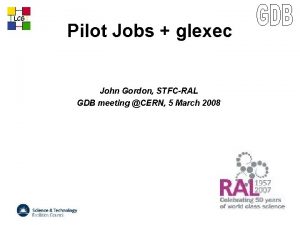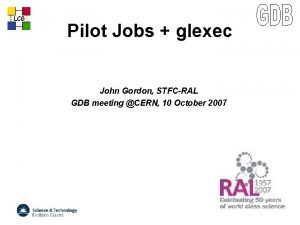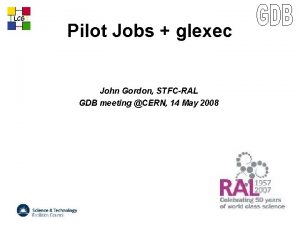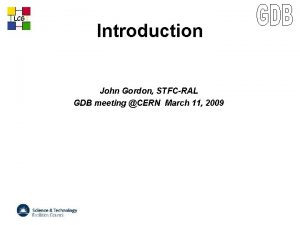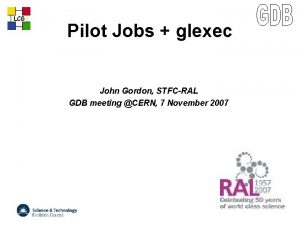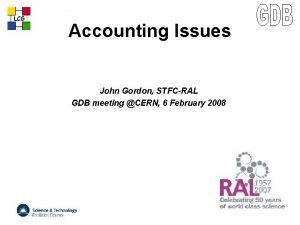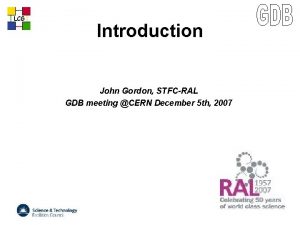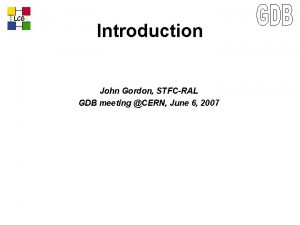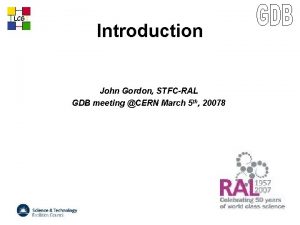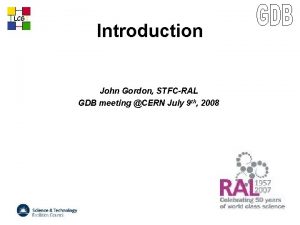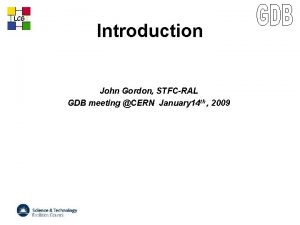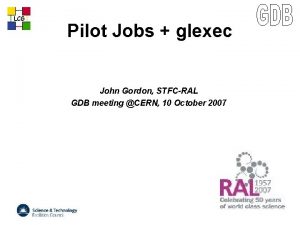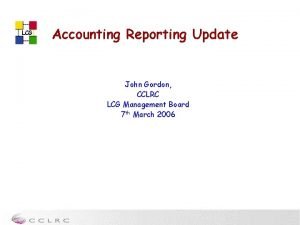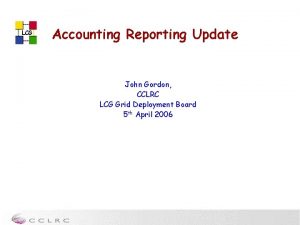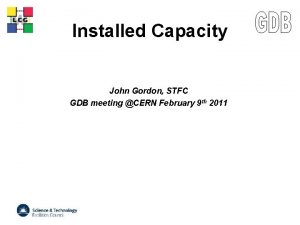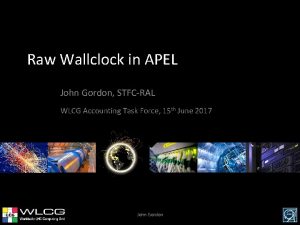LCG Tape Performance and Capacity John Gordon STFCRAL


















- Slides: 18

LCG Tape Performance and Capacity John Gordon, STFC-RAL GDB meeting @CERN January 14 th 2009

LCG Outline • I do not believe that WLCG has yet shown that it can deliver the tape performance required by the LHC experiments for their custodial data. • Discuss today, seek more information • Discuss again at February GDB • Present status and plans to LHCC mini-Review 16 th February 2

LCG I asked the Experiments a) Have you tested the ability of the T 1 s to take your RAW data and write it to tape in a timely manner? Would you notice if they had a lot of free disk and one tape drive shared by all experiments? In the long term that would not work but it might have been enough to receive data during the testing so far. b) Have you tested the ability of T 1 s to retrieve your data from tape? Either by pre-staging or in real time? 3

LCG ATLAS • Ran a prestaging test last year. Will repeat soon. • Results for February GDB 4

LCG Alice • A) Yes we have tested. • Would you notice if they had a lot of free disk and one tape drive shared by all experiments? • No, this is in the site fabric and not visible. • B) Only pre-staging and grouping multiple requests together is a viable option. Real time (from the running tasks) is impossible, this has been already demonstrated at CERN by the FIO group (tape performance presentations). 5

LCG I asked the sites. a) do you feel your tape system has been stressed by the LHC experiments yet? b) do you have a method of dynamically seeing the performance of your service to tape? 6

LCG BNL • a) Yes and no. While the system is, due to the vast majority of small ATLAS files (10 -500 MB), stressed in terms of tape mounts the aggregate bandwidth delivered is relatively low. ATLAS has addressed the issue and has implemented file merging for a variety of data categories. • b) We maintain a set of dynamically updated plots available at • https: //www. racf. bnl. gov/Facility/HPSS/Monitoring/for. Use rs/atlas_generalstats. html • There are 4 graphs for each of 9940 B and LTO tape drives (Usage", "More", "Flow", "Mounts"). • 7

LCG 8

LCG FZK • Use custom built tool to display data logged by dcache 9

LCG 10

LCG 11

LCG 12

LCG 13

LCG IN 2 P 3 A) CMS and ATLAS have done some tests of reprocessing data stored on tape in our site. The results of those tests are that the throughput we observed are under the expectations of the experiments. For instance, for the latest Atlas exercice in october we did not meet the target. 14

LCG IN 2 P 3 b) Below are the data we currently collect: • Throughput between d. Cache and HPSS (as perceived by d. Cache), for reading & writing data, in MB/sec – both agregated for the 4 LHC experiments, and per experiment • Tape drive usage, per drive type. For LHC experiments, only the usage of T 10. 000 tape drives is relevant. We measure: – – the number of drives in use the number of copy requests waiting for a cartridge to be available the number of copy waiting for a cartridge to be mounted the number of copy waiting for a tape drive to be free • Maximum mount time per drive type (in minutes) • Network bandwidth used by HPSS tape servers and disk servers: as the tape and disk servers are not dedicated per experiment, we currently don't have a means to get this information per experiment 15

LCG IN 2 P 3 • What currently don't have (at least, not systematically) is the distribution of the sizes of files on tape, per experiment, nor the number of files read or written per tape mount. • We don't have a means to easily correlate the activity of the experiments (as shown in their dashboards) to the activity on HPSS. • Looking at all the plots of the data we collect, our impression is that the problem we have is that the data on tape is not organized correctly so that the retrieval of them is optimized. We are currently exploring ways to improve the interaction of d. Cache and HPSS in order to organize the writing of the data on tape and optimizing the reading of those data (for instance, by making sure that d. Cache requests HPSS the copy of several files on the same tape, so that the tape is mounted only once). 16

LCG NDGF a) Yes, ATLAS has stressed it, but we haven't had a stress test since the last time we increased capacity. b) Yes, on multiple levels. There may be some good plots around, but since NDGF has many tape systems, the overview plots are kind of bland the detailed ones are per-tape system. 17

LCG What Next? • Information from all experiments on their testing/verification. Including repeated/updated tests. • Information from sites on their ability to monitor. • Share information on GDB list to prevent duplicate work. • Revisit at February GDB • Present conclusions to LHCC Mini-Review in February. 18
 Types of tapes used in surveying
Types of tapes used in surveying Lto comparison
Lto comparison Channel capacity planning
Channel capacity planning Lcg random
Lcg random Lcg
Lcg Lcg
Lcg Lcg projects
Lcg projects Lcg test
Lcg test Xjtu vpn
Xjtu vpn Lcg database
Lcg database Lcg webcast
Lcg webcast Bourbon triumvirate pictures
Bourbon triumvirate pictures Capacity planning performance management
Capacity planning performance management Moho subsystems
Moho subsystems Key performance indicators for capacity building
Key performance indicators for capacity building John kotter corporate culture and performance
John kotter corporate culture and performance Behaviorally anchored rating scales
Behaviorally anchored rating scales Performance levels
Performance levels Jcids process
Jcids process



